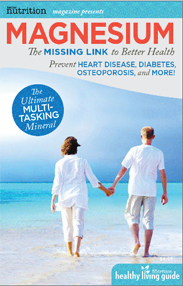Magnesium & Preterm Birth: Significant Risk Reduction of Cerebral Palsy & Death
The neuroprotective effect of magnesium given to pregnant women has been proven since 1995 in many studies and has been re-confirmed by two recent studies which are reviewed here:
Since there is no treatment for Cerebral Palsy (CP), preventing cerebral palsy would be “very desirable indeed,” asserts neurologist Karin B. Nelson of the National Institutes of Health (NIH) in Bethesda, Maryland. Dr. Nelson and her colleagues concluded a groundbreaking study in 1995 showing that very-low-birth-weight babies in four centers in California had a lower incidence of cerebral palsy when their mothers were treated with magnesium sulfate shortly before giving birth.
“This intriguing finding means that use of a simple medication could significantly decrease the incidence of cerebral palsy and prevent life-long disability and suffering for thousands of Americans,” said Zach W. Hall, Ph.D., director of the National Institute of Neurological Disorders and Stroke. The researchers calculated that magnesium sulfate reduced the prevalence of cerebral palsy by an astounding 90 percent and reduced the prevalence of mental retardation by about 70 percent. They speculate that magnesium may play a key role in brain development and possibly prevent cerebral hemorrhage in preterm infants.
Dr. Diane Schendel found very similar results the following year while studying a population in Atlanta. Those mothers receiving magnesium sulfate delivered infants with a 90 percent lower prevalence of cerebral palsy and a 70 percent lower prevalence of mental retardation. The researchers reported that at one year of age, only 1 out of 113 babies whose mothers received magnesium sulfate developed cerebral palsy. Only two of the babies had mental handicaps. In contrast, 30 of the 405 children whose mothers did not receive magnesium sulfate had cerebral palsy and 22 had handicaps. The investigators theorized that magnesium may prevent fetal brain hemorrhage or block the harmful effects of a diminished oxygen supply to the brain. As for those babies exposed to too much oxygen in an attempt to overcome intrauterine deficits, magnesium protects the lungs. A 2000 literature review suggests that magnesium chloride may be even more protective for the developing brain than magnesium sulfate.
Two recent studies, “Assessing the neuroprotective benefits for babies of antenatal magnesium sulphate: An individual participant data meta-analysis.” (PLoS Med. 2017 Oct 4;14(10) and “Fetal Neuroprotection by Magnesium Sulfate: From Translational Research to Clinical Application” (Front Neurol, 2018 Apr 16;9:247) confirm the previous findings noted above. The second study explains the mechanism by which magnesium offers neuroprotection as an N-methyl-d-aspartate receptor blocker and via its anti-inflammatory effects.
Quoting from the second study:
Furthermore, “meta-analyses of five randomized controlled trials using magnesium sulfate as a neuroprotectant showed amelioration of cerebral palsy at 2 years.” The research on magnesium sulfate is so compelling that “antenatal magnesium sulfate is now recommended by the World Health Organization and many pediatric and obstetrical societies, and it is requisite to maximize its administration among women at risk of preterm delivery before 32 weeks gestation.”
The first study concluded that:
“Antenatal magnesium sulphate given prior to preterm birth for fetal neuroprotection prevents CP and reduces the combined risk of fetal/infant death or CP. Benefit is seen regardless of the reason for preterm birth, with similar effects across a range of preterm gestational ages and different treatment regimens. Widespread adoption worldwide of this relatively inexpensive, easy-to-administer treatment would lead to important global health benefits for infants born preterm.”
Study References:
i Nelson KB et al., “Can magnesium sulfate reduce the risk of cerebral palsy in very low birth weight infants?” Pediatrics, vol. 95, no. 2, 1995.
ii Schendel D et al., “Prenatal magnesium sulfate exposure and the risk for cerebral palsy or mental retardation among very low birth-weight children aged 3–5 years.” JAMA, vol. 276, pp. 1805–1810, 1996.
iii Dedhia HV, Banks DE, “Pulmonary response to hyperoxia: effects of magnesium.” Environ Health Perspect, vol. 102, suppl. 10, pp. 101–105, 1994.
iv Oorschot DE, “Cerebral palsy and experimental hypoxia-induced perinatal brain injury: is magnesium protective?” Magnes Res, vol. 13, no. 4, pp. 265–273, 2000.
v Bara M, Guiet-Bara A, “Magnesium regulation of Ca2+ channels in smooth muscle and endothelial cells of human allantochorial placental vessels.” Magnes Research, vol. 14, nos. 1–2, pp. 11–18, 2001.
Newsletter
![]()

Want valuable information regarding the health benefits of magnesium, latest studies, expert interviews,videos and health tips? Enter your name and email address and you can start receiving valuable health information right away.
Featured On:








